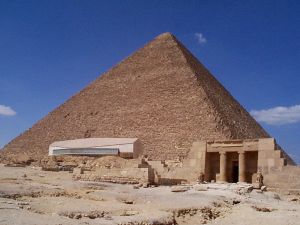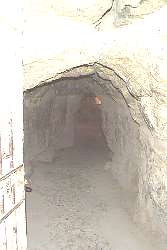|
~ The Great Pyramid |
||
The Great Pyramid
It is the one and only Wonder which does not require a description by early historians and poets. It is the one and only Wonder that does not need speculations concerning its appearance, size, and shape. It is the oldest, yet it is the only surviving of the Seven Ancient Wonders. It is the Great Pyramid. Location Background Not much is known about Cheops (Khufu). The tomb had been robbed long before archeologists came upon it. Any information about him was taken with the objects inside the tomb. He is thought to have been the ruler of a highly structured society and he must have been very wealthy. He was buried alone in this massive tomb. His wives may have been buried nearby in smaller mastabas. The encasing marble which covered the outside of the pyramid has eroded or been removed over time. With this casing off, the pyramid lost 33 feet (11m) of all of its dimensions. The top platform is 10m square. The base of the pyramid is 754 feet and covers 13 acres. The original entrance to the pyramid was about 15m higher than the entrance that is used today. Apparently Al Mamum, who opened up the new passage, could not find the original opening. The new passageway leads straight across and joins in with the original passage, the descending passage. The descending passage led only to a subterranean chamber. This descending passage that leads down is set at a 26 degree angle that descends down 345 feet (105m) into the earth under the pyramid. The passageway is only 3'6" (1.1m) wide and 3'11" (1.2m) high. The chamber is closed to the public. The chamber itself is room that measures about 46' x 27'1" x 11'6" (14 x 8.3 x 3.5m). There is a passage that leads 100 feet horizontally to the western side. The purpose of the pit is uncertain. It is possible that it could have been the burial chamber, but after a change of plan, it was abandoned.
At the point where the ascending passage levels off, you can go two different ways. If you continue on horizontally, this passageway leads into the Queen's Chamber. The Queen's Chamber was never used. The floor in this room was never polished, it's still rough. Egyptologists believe that the chamber was brought to this point and then the builders changed their minds and moved to the King's Chamber. The possible explanation for the abandonment is that the sarcophagus built for Cheops was much too large for the narrow passageways that had already been built. There are ventilating shafts that are another mystery. These shafts are sealed at the extremities on both shafts. The shafts must have been made as the pyramid went up, since the builders most likely would not have continued to make the shafts after the decision to abandon the chamber. It is also thought that these are not actually ventilation shafts, but more of a religious significance. This could be related to the Ancient Egyptian's beliefs that the stars are inhabited by gods and souls of the dead. The second, and more spectacular, way at the leveling off point of the ascending passage, is to continue upwards to the Grand Gallery. The gallery is 157 feet (48m) long and 28 feet (8.5m) high and is at the same 26 degree angle as the passages. The roof of the gallery is corbelled. It is said that not a piece of paper or a needle can be inserted between the stones making up the roof. The gallery is only 62 inches (1.6m) wide at the bottom and is only 41 inches (1m) wide at the top of the incline. The Grand Gallery leads into the King's Chamber. The walls of the chamber are made of pink Aswan granite. Inside this chamber is the very large sarcophagus made of Aswan red granite, with no lid. The sarcophagus must have been placed inside the chamber as the pyramid was being built. It is much too large to have been moved in afterwards, as was the usual custom of that time. The King's Chamber is 34'4" x 17'2" x 19'1" high (5.2m x 10.8m x 5.8m high). This chamber also has the possible ventilation shafts as the Queen's Chamber. They are at the same angle as the shafts in the Queen's Chamber. The thought about the religious significance applies to these shafts as well. The main feature of the sky at night, was the Milky Way. The stars were thought to have been the Nile in the sky. The southern shaft from the King's Chamber points directly to where Orion's Belt would have been in the ancient sky. The southern shaft of the Queen's Chamber points to Syrius. The northern shaft of the King's Chamber points to the circumpolar stars. These stars never disappear in the sky. It is thought that these shafts were to help the spirit of the dead pharaoh find the important stars. Above this chamber is a series of five relieving chambers which are essential to support the weight of the stones above and to distribute the weight away from the burial chamber. The top chamber has a pointed roof made of limestone blocks. This is the most important of the relieving chambers. In these chambers, are found the only inscriptions in the whole pyramid. The
fascinating feature of the Great Pyramid A Frenchman named Bovis once discovered that some animals which had wandered in and died there, did not rot. Their bodies simply dried out and were preserved like mummies! Furthermore, in 1959, a Czech engineer found that if a blunt razor blade was placed on a stand in the centre of a model of the Great Pyramid, it became sharp again. Amazing isn't it? In the 1960s, there was a pyramid craze in America. Some people even bought pyramid-shaped tents in which to meditate. Those who ate, worked and slept in the tent believed it made them more efficient! Some serious believers of 'pyramid power' even tried to use it to predict events of the future, but to their embarrassment, their attempts usually failed. Over the next few decades, believe in 'pyramid power' gradually decline. Today, the Great Pyramid attracts tourists curious to see its size rather than the power it may behold. However, its sheer size and age is so awesome that most people will continue to feel that there is something mysterious about the pyramid.
|
||

 Man
fears Time, yet Time fears the Pyramids
Man
fears Time, yet Time fears the Pyramids The
descending passage beyond where the new entrance meets it, is closed
off by a steel door. The ascending passage rises at the same angle
as the descending, 26 degrees. The ascending passage leads up into
the pyramid. The ascending passage is the same dimensions as the
descending, 3'6" (1.1m) wide and 3'11" (1.2m) high. It
can be quite a difficult trek for some people. The passage leads
on for 129 feet (39m).
The
descending passage beyond where the new entrance meets it, is closed
off by a steel door. The ascending passage rises at the same angle
as the descending, 26 degrees. The ascending passage leads up into
the pyramid. The ascending passage is the same dimensions as the
descending, 3'6" (1.1m) wide and 3'11" (1.2m) high. It
can be quite a difficult trek for some people. The passage leads
on for 129 feet (39m).